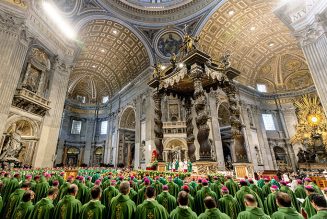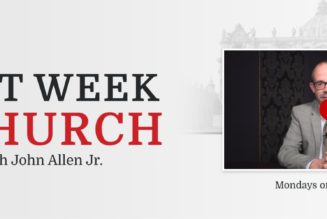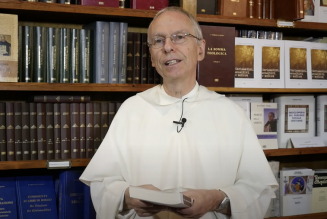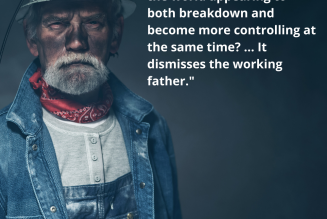Happy Friday friends,
And a happy feast of the Nativity of John the Baptist for tomorrow.
Of all the figures in the New Testament (saving our Lord, obviously), I confess John is the one whom I find most fascinating, and the narrative of his life most compelling.
I laugh a little every time I read the account of his naming, at how infuriated Zachariah must have been with the neighbors who “made signs to his father, inquiring what he wanted him to be called,” since he was struck dumb, not deaf, by the angel in the Temple.
I wonder about John’s upbringing, and what the child who lept in the womb to herald the presence of the unborn Christ would have been like as a child.
And I’m curious what his father the priest would have made of his son growing up to become the wild man of the desert, feeding on locusts and honey, covered in camel skins, and presumably bee stings.
I find myself internally cheering at the fury with which John denounces the viperous hypocrisy of the overtly religious but faithless, but convicted alongside them as he announces with terrible urgency the coming of the kingdom. And I’m deeply curious about how his clearly pastoral, but no less unflinching, conversations with Herod must have gone during his imprisonment.
There are saints I’d like to buy a beer, saints I’d like to hear my confession, and saints I’d want to ask advice from. But given the option of an hour with John the Baptist, I don’t know what I’d want to do or say or ask.
I suppose my reaction to him wouldn’t be that dissimilar to that of Herod, who (Mark records) “feared John, knowing that he was a righteous and holy man” but “when he heard him, he was greatly perplexed, and yet heheard him gladly.”
That Herod heard him gladly and still had him killed is a lesson to me, I suppose, about the need to constantly ask if any of the Church’s urgent warnings to me are actually changing my life, or if I’m treating them as just compelling content — in this line of work, that risk is real.
With that in mind, let’s get to the news.
The News
The Archdiocese of Saint Paul and Minneapolis announced yesterday that Bishop Lee Piché is returning to ministry in the archdiocese as vicar for retired clergy.
There was a lot going on in the MSP archdiocese at that time, and Nienstedt faced accusations of misconduct personally, and there was a lot of coverage back then of an investigation he ordered into himself which his other then-auxiliary Bishop Andrew Cozzens called “doomed to fail.”
Since then, of course, we’ve got Vos estis. And I think it’s fair to say the experience of Minnesota made a serious contribution to the creation of that document.
According to the archdiocese yesterday, in the eight years since the bishop’s resignation, “Bishop Piché has embraced a life of prayer and penance for the intention of victims of abuse in the archdiocese, and for efforts to bring healing into the lives of those who have been impacted in any way by clergy abuse.”
—
A seminary in the Nicaraguan city of Bluefields announced this week it would cease operations, after the government froze its bank accounts last month.
Church leaders say the alleged money-laundering is actually a charitable microloan program, and that the allegations of financial corruption are a pretext for the country’s government to seize Catholic properties and silence the Church.
You can read all about the case here, and please do.
And please remember the Church in Nicaragua in your prayers. They need them, badly.
—
Four of Germany’s 27 diocesan bishops combined this week to block funding for the committee created to implement the resolutions of the country’s controversial “synodal way.”
Their decision means that supporters of the synodal way must find an alternative source of funding for the “synodal committee” — a body about which the Vatican has expressed serious reservations — ahead of its scheduled first meeting in November, right after the synod of bishops meets in Rome.
But this is not the end, as Luke Coppen makes clear in his analysis this week.
—
Speaking of synods: also this week, we also covered the launch of the working documents for the October meeting of the Synod of Bishops.
But perhaps just as interestingly, the synod is going to be going for a different look and feel during its session this time, moving to the kind of small, round-table seating which has become normal for USCCB meetings but is going to be novel in Rome.
You can read all about the new-look sessions here.
—
This week, Ferrucio Pannico died, aged 63, at his family home in Turin. If you don’t know his name, you should.
Pannico was the deputy auditor general of the Vatican until 2017, when he and his boss and longtime friend Libero Milone were forced from their jobs and threatened with criminal prosecution of “spying” on (some would call it “auditing”) the financial affairs of powerful cardinals, Pillar reader Cardinal Angelo Becciu in particular.
At the time of their ousting, Vatican gendarmes raided and locked down the men’s offices, seizing everything in them. That included Pannico’s personal medical records — he was undergoing a series of diagnostic tests at a Vatican clinic, because of some indicators of prostate cancer.
Despite repeated requests, those files were never returned to him and Pannico had to start his diagnostic process all over again.
That ended in a terminal diagnosis of Stage 4 prostate cancer, of which he died this week.
Pannico said that if he’d got his medical paperwork back, his diagnosis would have come much earlier — and his treatment, too.
“I estimate that the delay in the diagnosis could be at least 12 months, and I think that without this delay in the diagnosis it would have been early enough not to have an incurable disease,” Pannico said back in November.
“I think they — the Vatican — are guilty, not maliciously, of sentencing me to death for no reason, after a slow and significant suffering.”
Pannico and Milone have a pending lawsuit against the Vatican Secretariat of State for wrongful dismissal, and loss of earnings and reputation, which Panicco said he was pursuing primarily to provide for his wife, whom he knew was soon to be widowed.
You can read the whole story here.
—
Cardinal Gianfranco Ghirlanda, S.J., was named the new cardinal patron of the Sovereign Military Order of Malta this week, replacing Cardinal Raymond Burke in the office.
Ghirlanda succeeding Burke is interesting, because it is one giant of canon law replacing another in what has traditionally been a somewhat sleepy and ceremonial role.
As I wrote in an analysis this week, the two cardinals have also played key — though very different — roles in the order’s recent years of internal upheaval and constitutional reform. In many ways, you could say that one began the whole process, albeit unintentionally, and the other completed it, both under historically unusual legal circumstances.
Quiet time
Pope Francis this week imparted a special blessing upon a monstrance which will see service in the National Eucharistic Congress next year.
The pope used the occasion to give his thoughts on the Congress, and the practice of adoration in general.
“Indeed, the Eucharist is God’s response to the deepest hunger of the human heart, the hunger for authentic life because in the Eucharist Christ himself is truly in our midst to nourish, console, and sustain us on our journey.”
It was, I thought, a beautiful reflection. The natural symbiotic relationship between spending time before the Lord in the sacrament and going out to share an experience of Him with all we meet is, I think, intuitive.
In my spare time, such as it exists, the most rewarding thing I get the privilege of helping out with is a monthly Bible study/Eucharistic adoration for local college-aged and recently graduated Catholics.
(I don’t say “young people” because my experience has been, getting to know them, that the problems they are facing in their families, working life, and social circle are at least as “adult” as mine.)
The afternoon starts with a brief catechesis followed by some time spent with the Gospel of the Sunday, then a chance for them to reflect and speak about what’s going on, where God is at work in their lives, and where they need Him more. Then we have solemn vespers with adoration and benediction, with a pot luck afterward.
It’s a good crowd, normally about 20-30 people, and they come and go. You’d think, certainly I assumed, that the more obviously “dynamic” half of the day would draw the bigger crowd, but I’ve noticed that about a third of our regulars tend to come later, just for the adoration.
I don’t think that is accidental. And these are not people who spend their days exclusively ensconced in devout Catholic social circles, or are otherwise conditioned for traditional forms of popular piety.
But they spend their weeks in the world, trying as best they can to be salt, light, and leaven at work, on campus, and very often in their homes, too. They understand and want to spend time, as the pope said this week, “in the consoling presence of Jesus and there to draw the apostolic impetus to be instruments of goodness, tenderness and welcome in the community, the Church, and the world.”
“This inner movement,” said the pope, “will make possible a service to others that is not philanthropy or welfarism, but openness to the other, closeness, sharing; in a word: charity.”
This has certainly been my experience. Faith without works is dead, as St. James rightly wrote. But, as has been often observed, throwing ourselves into good works without the cultivation of our own faith will soon leave them sterile gestures of what Francis calls “welfarism.”
Such works are, I think, to borrow a Gospel image, seed that falls on the rocky ground — quick to spring up, but soon left desiccated if not watered with time spent quietly with the font of authentic love.
However well intentioned, the disposition to works without faith soon becomes parched and brittle and, I think, reflexively hostile to just the kind of interior life and devotion the pope is calling for.
The wisdom of children
One of the things I don’t like to do in these newsletters, so far as I can avoid it, is wade into what we call the culture wars.
If people want to read hot takes on emotive news-adjacent issues, I tend to think the market already overserves that particular need. I’m also a big believer that there should be, pardon the expression, safe spaces where people can write and read about the news apart from the wider noise of otherwise omnipresent and often splenetic public debate.
And, frankly, I don’t tend to think my opinions or insights, however strongly held, necessarily merit being broadcast into the world.
But I’ve been mulling something after last week’s USCCB meeting, and after reading an article on a related issue I feel like there’s something worth pointing out on the “trans debate” as it pertains to the Church. So here we go.
Apparently, senior leadership at the school had to get involved because the Year 8 student (12-13 year olds) was left “really upset” by her classmates’ refusal to accept she is really, deep down, a cat, and that she should only be acknowledged and treated as such. The incident came during a class in which the children were being taught about gender identity, with several students pushing back on the premise that there are multiple genders, including self-identification as an animal.
According to the Telegraph, similar verified incidents are cropping up in U.K. high schools more and more often, even while the internet is awash with hoax reports of litter boxes in school bathrooms.
The Telegraph also identified and verified cases of kids insisting they were horses and dinosaurs, as well as one who wears a cape to school and asserts that “they” are a moon.
“The child in question did not identify as the Moon, but as a moon, and said they could put curses on people,” the paper helpfully clarified.
Teachers and school administrators are deeply concerned about this, it seems. Unable and unequipped to distinguish between clinical cases of gender dysphoria and the absurd, inevitable results of gender ideology, they are bending over backward to accommodate the “catselves” of their pupils, even when it means they will only meow in response to questions and instructions. (Really. This is not a hypothetical or an internet hoax. This is documented and acknowledged by the schools in question.)
Two things struck me about this report.
First: That the hypersensitivity of the teachers comes just as the tide of medical opinion in the U.K. seems to be turning in the debate about how best to respond to children apparently manifesting symptoms of actual gender dysphoria and related conditions.
Second: That it is children themselves who are pushing back on the prevailing orthodoxy of gender ideology (which is distinct) and, at least according to the Telegraph’s report, growing resentful of what they see as a social media trend obstructing their education.
“While other pupils would be pulled up for wearing non-uniform items, such as facial piercings or dyed hair, children who identified as cats or moons would be allowed to wear cat ears or cloaks to express their ‘true self’, breeding resentment among other pupils,” the paper reported, while quoting several students in the affected classes.
The whole report supports two points, one I have long suspected and one I was surprised by.
I’ve grown accustomed to reports and polls appearing to show that the limitless scope for self-identification as a right is a matter of demographic inevitability; that younger generations buy into male and female (or human) identity as oppressive social constructs.
This has always struck me as unlikely, especially as that premise becomes more and more entrenched in the teaching profession.
As a kid in the 80s and early 90s, I remember being force-fed a great deal of ideological claptrap by my Catholic grade school teachers in Chicago, all under the guise of legitimate concern for environmental issues. While I now know the recycling industry to be a titanic scam, I first intuited this as a fourth grader for the simple reason that I found Miss Jacobs’ emotive insistence on the morality of the practice shrill and unreasonable.
But if I’m not surprised by these British school kids’ skepticism, I am shocked by the maturity of their approach — calmly and patiently explaining to a newspaper (and their teachers) how the whole gender ideology agenda is derailing classroom focus and their ability to learn.
If a 12-year-old me had seen a classmate turn up to school in “a Harry Potter wizard cape” and receive special treatment for their “moonself,” I’d have spent the day brainstorming what outrageous identity I could concoct to garner concessions of my own.
These kids seem to have a seriousness I lacked at their age, and a willingness to speak plainly, and without the emotive equivocation so often found in our wider discourse.
It is a trait, I would note, shared by our Holy Father.
“Today children — children — are taught in school that everyone can choose his or her sex. Why are they teaching this? Because the books are provided by the people and institutions that give you money. These forms of ideological colonization are also supported by influential countries. And this is terrible!” so said Pope Francis in 2016.
Myriad Vatican documents have echoed the pope’s verdict since then, and earlier this year, Francis revisited the subject in an interview with an Argentine newspaper, in which he said that “Gender ideology, today, is one of the most dangerous ideological colonizations.”
The pope’s clarity rang loudly in my ears last week in Orlando, as I watched a group of bishops, led by Cardinal Robert McElroy of San Diego, line up to call for the broadest possible consultation during the revision of the bishops’ guidance for Catholic hospitals on transgender medical interventions.
“I think there’s a fundamental difference between a declaration on doctrine,” McElroy said, “and the formulation of the Ethical and Religious Directives” for Catholic health care services.
McElroy, along with Cardinal Joseph Tobin and Cardinal Blase Cupich — who wasn’t present but spoke through an intervention from one of his auxiliary bishops — spoke from the floor on the need for consultation in reformulating the ERDs to reach “people who are from the trans community,” to produce a “pastoral” document reflective of “the existential situation of people” suffering from gender dysphoria.
Of course, consultation is good — and broad consultation is, generally speaking, better. And every text produced by the Church should be pastoral and phrased best to respect and address the dignity and pain of those in situations of suffering and to help them accept the healing nature of the truth.
In this, I think Cardinal McElroy and the other bishops who spoke make an important point. It’s easy enough to say “the Church says x, so the best thing is to write X in capital letters and be done with it,” but whom, really, does it help — whom does it evangelize — and how does it manifest the love and radical proximity of Christ to those who are affected most deeply and personally by the issues being discussed?
The ERDs are not, as Cardinal McElroy said, simply a recitation of doctrine. They are a kind of legal text, which as a discipline in the Church is a form of practical systematics. If the ERDs are where the rubber meets the road, the tires need to have some grip on lived reality if they’re going to get anywhere.
Broad consultation, of course, cannot become an euphemism for accommodating truth to the kind of “ideological colonization” denounced by the pope — but the bishops themselves distinguished between clinical gender dysphoria and the agenda of gender ideology in their remarks from the floor.
So one hopes, and expects, that the eventual drafts will lean heavily on Francis’ own words and thoughts on the subject.
But I also hope they will be characterized with the sort of ecclesiastical bedside manner which makes sure the Church’s teaching goes down as a tonic, not an emetic. This is, presumably, exactly what Francis means when he speaks about the Church as a field hospital.
See you next week,
Ed. Condon
Editor
The Pillar
Comments 28
Services Marketplace – Listings, Bookings & Reviews










![My Gay Father-in-Law [Must-Read]…](https://salvationprosperity.net/wp-content/uploads/2024/01/my-gay-father-in-law-must-read-327x219.jpg)
